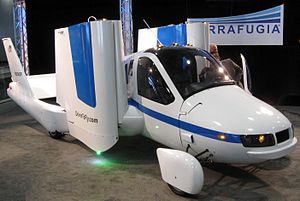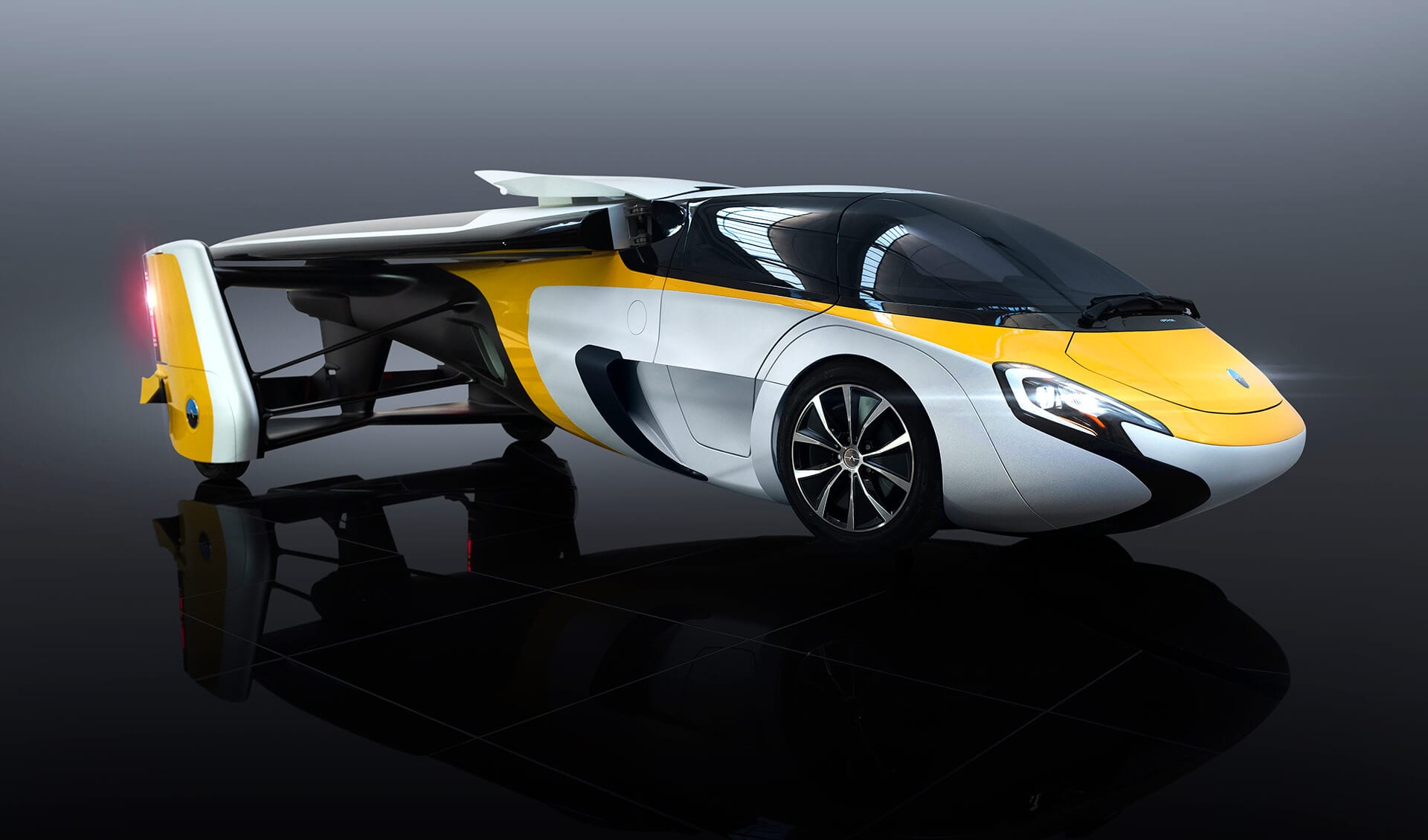Has George Jetson’s Flying Car Finally Arrived?
The flying car has been America’s dream of the future for decades. Flying cars graced the covers of Popular Mechanics year after year. The popular Jetsons cartoons from the 1960s featured the family jetting to work and school in a flying car that folded up into a briefcase.
The flying car is right up there with the personal jet pack for cool but unrealized technology.
Until recently the dream of a flying car has been nothing more than that; just a dream.
Most efforts to actually build one were attempted by overly ambitious crackpots who tinkered with fan jets and rotating wings in their garage.
But that has now changed.
Big names and big players are investing heavily in the flying car business.
They include Google founder Larry Page, the aviation giant Airbus, and transportation kingpin Uber.
Several of the contenders have produced some fancy videos showing off their futuristic prototypes, and the Chinese drone company eHang demo’d their first flying car at the CES 2017 show in Vegas.
There is one company already selling pre-orders for their futuristic looking Flying Car, the Aeromobil, and a second company taking deposits for their Terrafugia Transition flying car.
So surely, the dream is now becoming a reality … right?
WHY THE FLYING CAR IS STILL GROUNDED
In reality, the use of anything resembling a flying car still faces a long road ahead, especially for widespread adoption.
While the idea is cool, the truth is there’s not much appetite anywhere in the world for poorly trained pilots flying small aircraft through crowded urban areas.
Some companies, like Uber and Airbus, are now trying to develop robotic flying cars that fly themselves on pre-determined routes, but this option may be even farther from reality.
Still, some very large and experienced aerospace companies are making serious investments in this space, convinced that advances in Artificial Intelligence, multi-rotor drones, and renewable batteries will allow this industry to finally ‘take off’.
The biggest issue is that while they are called ‘flying cars,’ these devices are actually aircraft, and aircraft face certain issues that cars do not.
For one, maintenance of aircraft is difficult, expensive, and must be done on a constant basis. The reason flying helicopters or private jets is so pricey is that the entire engine must be replaced after a relatively short period of time.
Having a ‘car’ flying every day to and from work would likely mean replacing the engine every year or two.
As well, battery technology just isn’t up to the task of carrying humans through the sky, over a crowded city, hour after hour. If your Tesla runs out of battery power you can pull off the road. If your electric flying car runs out of juice you fall through the roof of a mall or school or apartment building.
Some flying cars actually feature parachutes that automatically deploy if you run out of power … and who doesn’t want to do a little skydiving on the way to work?
Finally, whether piloted by humans or by AI, the skies around cities are pretty crowded, and the idea of adding thousands or millions of flying cars is a waking nightmare for the Federal Aviation Authority.
Nevertheless, a lot of large corporations and small startups are betting they can overcome these hurdles … and to some extent they are probably right.
Whether they ever see widespread adoption, there’s no doubt you will see at least some of these flying cars in the air within the next five years.
Here’s a short summary of the major Flying Car projects worldwide, and where they are in the development cycle.
AEROMOBIL
This Slovakian startup is arguably the furthest ahead in developing a true flying car. The Aeromobil is a working prototype that drives like a car on the road, and converts in three minutes to a fixed wing aircraft.
Unlike George Jetson’s commuter car, and many of the Vertical Takeoff and Landing (VTOL) craft in this list, you have to drive your Aeromobil to the airport to take off.
The flying car is designed with the wealthy executive in mind. Cost is about $1.6 million USD, but the car would allow a person to drive to their local airport, fly to another airport in another city, and then drive to their next appointment.
For now, we’ll probably just keep going out to the taxi line.
TERRAFUGIA
 The American designed Terrafugia is now taking in deposits for their ‘Transition’ model, which looks much more like a light plane than a flying car.
The American designed Terrafugia is now taking in deposits for their ‘Transition’ model, which looks much more like a light plane than a flying car.
The Transition is a working model though, and is already cruising the skies on test flights.
The craft flies at 100 miles per hour (160 kph), will carry two fairly hefty adults, and has a range of 400 miles (600 kilometres) in the air.
On the ground the wings fold up and the pilot becomes a driver, cruising the highway in what looks like a broken airplane.
Like the Aeromobil, there definitely is a market for this craft, but it’s also nothing close to being usable as a daily work commuter.
Terrafugia is also working on the much cooler looking TF-X, which takes off vertically and doesn’t require an airport for takeoffs and landings.
PROJECT VAHANA
This project is still shrouded in mystery, but gains credibility because the flying car startup company A3 is owned and funded by the aviation giant Airbus. Earlier this year Airbus CEO Tom Enders said the first flying prototype would be ready by the end of 2017.
The Vahana is a Vertical Takeoff and Landing (VTOL) aircraft with eight rotors sprouting from stubby wings at the front and back of the craft.
It’s not flown by a human pilot; instead the Vahana is an autonomous drone that carries humans as cargo.
Airbus is in the passenger business, and says the Vahana would be deployed as an airborne taxi service that people can summon with a mobile app.
How close is Vahana to reality?
Not too close.
The company admits the technology isn’t there yet to avoid obstacles in the sky, like birds or other aircraft, but A3 CEO Rodin Lyasoff believes the Vahana will be a ‘productizable demonstrator’ by 2020.
THE EHANG 184
This Chinese drone company showed off its flying car concept at the Consumer Electronics Show in Las Vegas, but still has work to do before the Ehang 184 is ready for prime time.
The Ehang 184 is an autonomous drone with multiple rotors, large enough to carry a single human.
The occupant can simply bring up the craft’s navigation screen, enter where he or she wants to go, and the Ehang 184 will plot a course and fly there with no further human intervention. The company is building in object avoidance as part of the software, and in the event of an equipment malfunction the craft will automatically land.
KITTYHAWK AND ZEE.AERO
Both of these companies have been personally funded by Google co-founder Larry Page, who is pouring some serious money into flying cars.
Bloomberg reports Page has funded Zee.Aero to the tune of $100 million, and has invested an unknown amount into Kittyhawk.
The Zee.aero project remains highly secretive. The company’s website is a black screen that simply states it is “… developing a revolutionary form of transportation.”
Patent filings show a small aircraft with rows of propellors arranged like an outrigger canoe, but little else is known about the project.
KittyHawk is closer in concept to the Ehang 184. It’s a quadcopter that’s more a flying motorcycle than a car, carrying a single pilot. The prototype is already flying test flights at low altitude over lakes, freaking out local boaters and water fowl.
While very basic, the prototype looks very useable for low altitude, short flights, and would probably be very popular as a recreational aircraft.
VOLOCOPTER
If autonomous ‘flying cars’ are to become a reality, the German startup company E-Volo may be the first to make it happen.
E-Volo has announced an agreement with the United Arab Emirates to test an “Autonomous Air Taxi” service from the airport in Dubai. The project starts in late 2017 and will last for five years.
So, robots flying humans through the air is now a thing.
E-Volo’s prototype Volocopter looks like a traditional helicopter with a large dreamcatcher stuck on top. The craft gets lift from 18 small rotors, and even if two or three failed the craft automatically compensates to maintain level flight. If things really go wrong, the craft will deploy a parachute and the occupants will safely drift to the ground … and hopefully not in front of an oncoming truck.
The Volocopter really doesn’t qualify as a ‘flying car’, but it is small enough and simple enough to become a practical people mover at relatively low cost.
One big test for the Volo will be whether the electrical engines and batteries can stand up to continuous, all day use.
The other will be safety. If a Volocopter collides with an object in flight or crashes, it would likely set back the use of autonomous aircraft by several years.
UBER
The last major player in the space is Uber, the immensely profitable and equally controversial ride sharing company.
It’s common knowledge Uber is trying to develop an autonomous ground taxi fleet, but its ambitions in the air are not as well known.
But Uber plans to launch a system of autonomous flying cars as a demonstration project in 2020, and start full-scale Uber air transport in Texas by 2023.
Uber also has some impressive tech partners on the project, including US-based Bell Helicopter, Brazil’s Embraer and Slovenia’s Pipistrel.
The so-called ‘Elevate’ network would see Uber establish ‘vertiports’ where its multi-rotor flying cars would take off and land.
Like E-Volo, Uber is working on a demonstration partnership in Dubai that will be in place for the 2020 World Expo, with another pilot in Dallas the same year.













VTOL is a sine qua non. as forward speed is the prime danger of vehicles.
Noise level must be controlled.
Lifting mechanism must be highly dependable and robust (safe functional fault tolerance).
Initial cost is unimportant, since mass production will bring it down.
Navigation must include collision avoidance and all basic flight functionalities of heading
distance range and altitude.
Maintenance must be simplified and steady state composites are recommended.
The craft must be equipped with radar and storm scope, or be networked to such,
continuously under pain of immediate landing.
Aerial routes must be established away from existing routes for other aircraft and
automated flight is required.